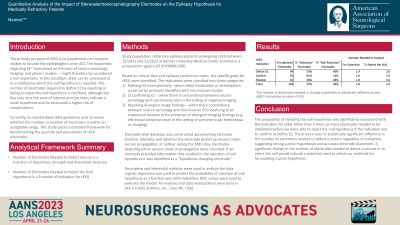Quantitative Analysis of the Impact of Stereoelectroencephalography Electrodes on the Epilepsy Hypothesis for Medically Refractory Patients
Friday, April 21, 2023


Kristin Nosova, MD
Resident
Banner University Medical Center
Sacramento, California, United States
ePoster Presenter(s)
Introduction: Stereoelectroencephalography (sEEG) is rapidly growing in utilization for medically refractory epilepsy. Its capacity for sampling network activity in an epileptogenic zone (EZ) is especially useful given the rise of neuromodulation. While benefits of sEEG are well-documented, no standardized guidelines exist regarding the implantation of intracranial electrodes for seizure localization. Nonetheless, the implantation process necessitates strategic decision-making guided by data-driven hypotheses. This study examined the role of implanted electrodes relative to presurgical hypotheses, evaluating potential markers for efficacious sEEG use and hypothesis formation.
Methods: Retrospective chart review of refractory epilepsy patients undergoing sEEG between 12/2021 and 09/2022 was conducted. Primary sEEG indications were classified as: 1) Defining EZ more precisely, 2) Resolving divergent image findings, and 3) Confirming EZ in the setting of concordant data and negative imaging. Differences between pre and post-sEEG EZ hypotheses were noted, and electrode-level data was categorized by seizure detection role.
Results: 136 electrodes across 16 patients were analyzed. All patients underwent a surgical intervention post-sEEG (63% RNS, 32% LITT). Defining EZ was the most common sEEG indication (69%), followed by confirming EZ (38%), and resolving image findings (31%). Post-sEEG, 38% of patients with hypothesized unilateral onset were shown to be bilateral. A number-needed-to-treat analysis (NNT) across all indications demonstrated that 1.8 electrodes were needed for seizure detection. For sEEG performed to confirm EZ, 10 electrodes were needed to change the EZ hypothesis. For sEEG performed to define EZ or resolve discordant findings, the 2 and 3 electrodes were needed for an EZ hypothesis change, respectively.
Conclusion : As excessive SEEG electrode implantation can increase complication risk and complicate interpretation, obtaining the most salient information with the lowest possible number of electrodes is critical. Our NNT analyses highlight the effect of proper hypothesis formation on optimal sEEG execution strategy. Further research is needed to elucidate the implications of these results.
Methods: Retrospective chart review of refractory epilepsy patients undergoing sEEG between 12/2021 and 09/2022 was conducted. Primary sEEG indications were classified as: 1) Defining EZ more precisely, 2) Resolving divergent image findings, and 3) Confirming EZ in the setting of concordant data and negative imaging. Differences between pre and post-sEEG EZ hypotheses were noted, and electrode-level data was categorized by seizure detection role.
Results: 136 electrodes across 16 patients were analyzed. All patients underwent a surgical intervention post-sEEG (63% RNS, 32% LITT). Defining EZ was the most common sEEG indication (69%), followed by confirming EZ (38%), and resolving image findings (31%). Post-sEEG, 38% of patients with hypothesized unilateral onset were shown to be bilateral. A number-needed-to-treat analysis (NNT) across all indications demonstrated that 1.8 electrodes were needed for seizure detection. For sEEG performed to confirm EZ, 10 electrodes were needed to change the EZ hypothesis. For sEEG performed to define EZ or resolve discordant findings, the 2 and 3 electrodes were needed for an EZ hypothesis change, respectively.
Conclusion : As excessive SEEG electrode implantation can increase complication risk and complicate interpretation, obtaining the most salient information with the lowest possible number of electrodes is critical. Our NNT analyses highlight the effect of proper hypothesis formation on optimal sEEG execution strategy. Further research is needed to elucidate the implications of these results.
